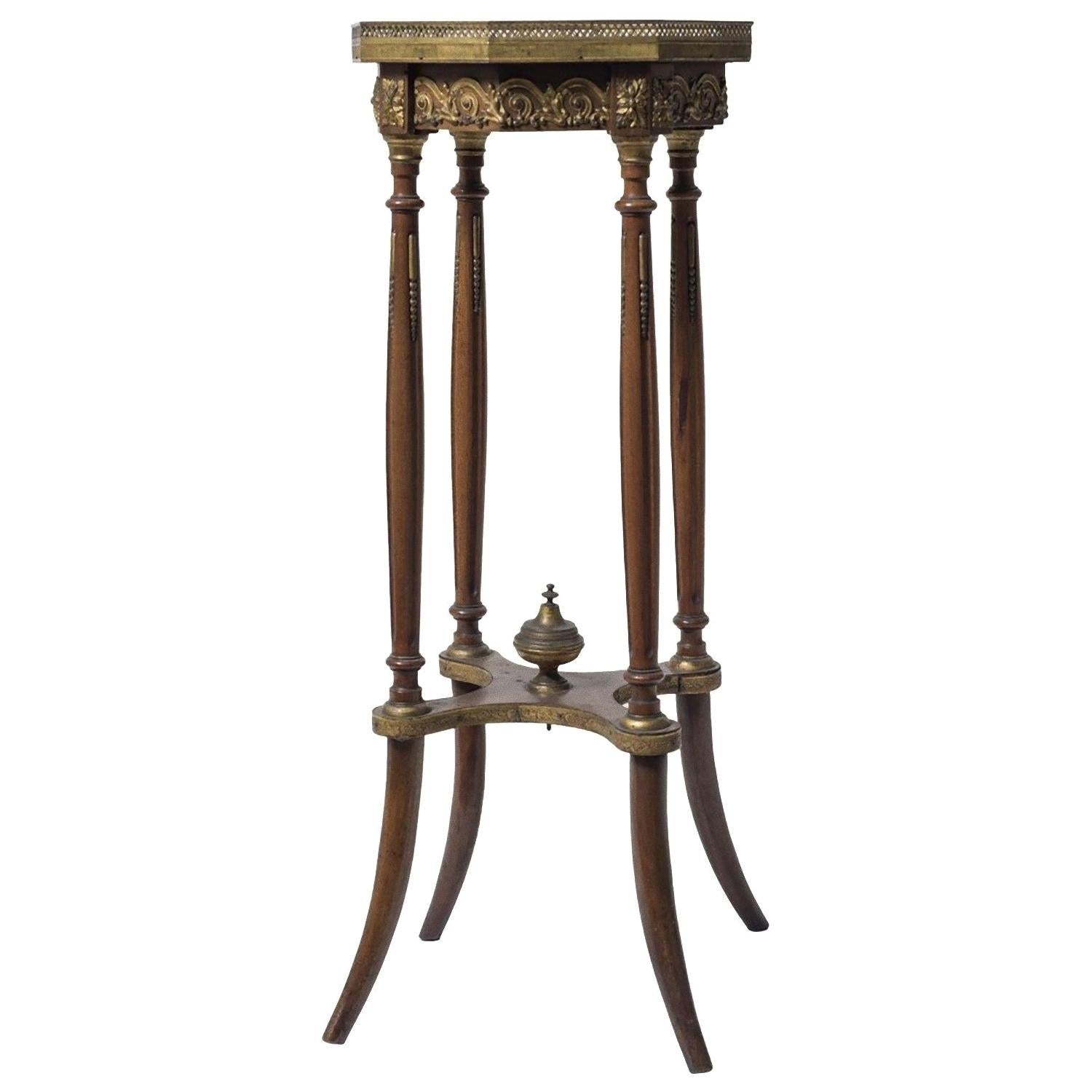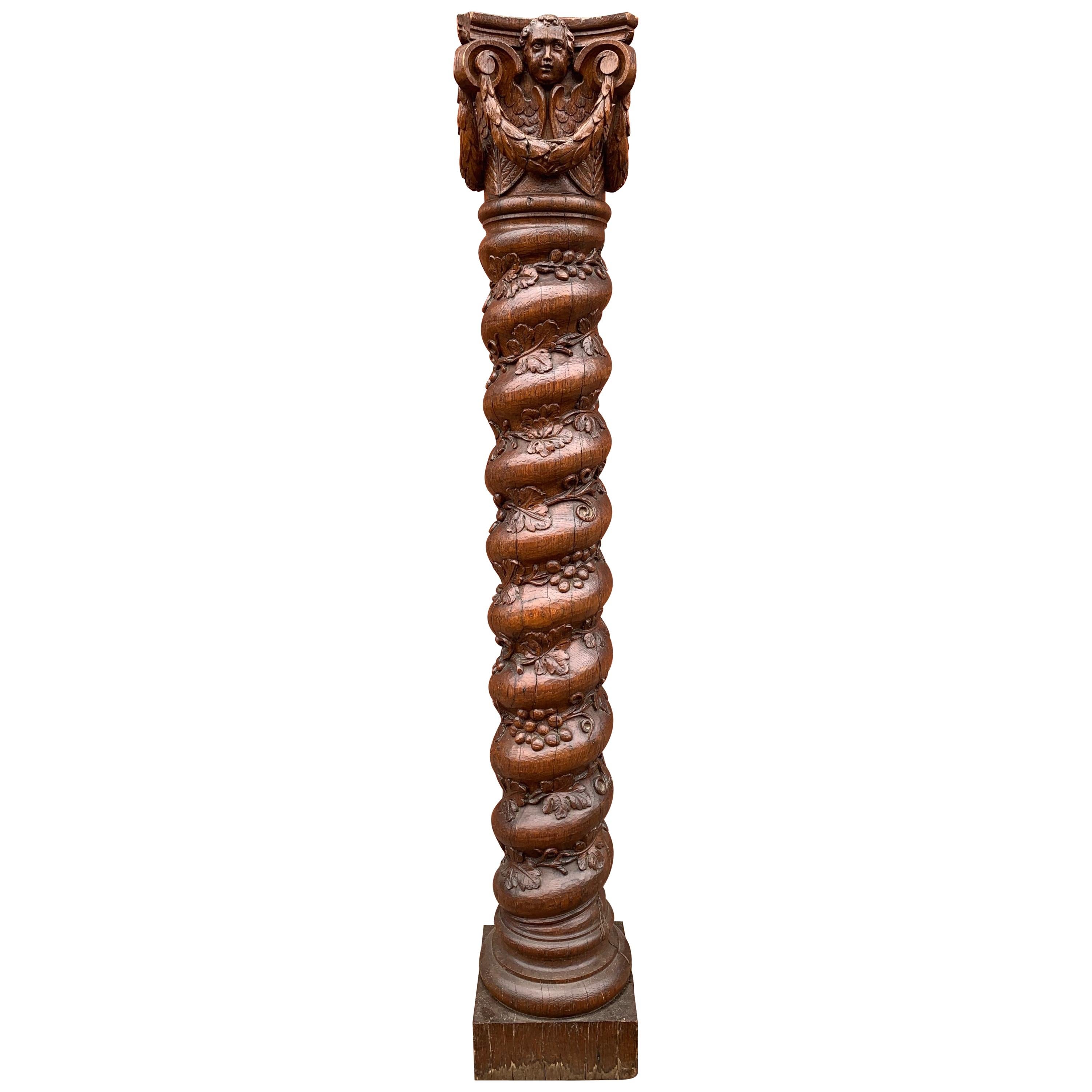Items Similar to 18th Century Rosewood and Oak French Convertible Music Stand by N. Grevenich
Video Loading
Want more images or videos?
Request additional images or videos from the seller
1 of 22
18th Century Rosewood and Oak French Convertible Music Stand by N. Grevenich
About the Item
Nicolas Grevenich
Convertible music stand
France, last quarter 18th century.
Bois de rose and oak
Measures: H 26.77 in; when open H max 44.09 in
Top: 16.14 in x 12.79 in; when open 16.14 in x 13.38 in
H 68 cm; H when open max 112 cm
Top: 41 cm x 32.5 cm; when open 41 cm x 34 cm.
lb 12.12 (kg 5.5)
A highly worn stamp under the tripod base bears the partial inscription “N ....ENICH”
State of conservation: good
Built of oak completely finished in bois de rose veneer, the stand is composed of a rectangular top supported on an octagonal column with tripod feet on casters.
By means of rather complex mechanisms, it is possible to increase the height by half, tilt the top and transform it into a two-sided lectern/music stand with adjustable inclination.
We have little biographical information about Nicolas Grevenich: he was probably born in the Rhine area of Germany but lived and worked almost his whole life in Paris, where he was named maître in 1768.
Documentary sources reveal that he was still receiving important commissions from the royal Garde-meuble in 1791, especially for the Tuileries Palace. His workshop was still active during the Empire period.
Bibliography:
DE SALVERTE F., Les ébénistes du XVIIIe siècle – leurs oeuvres et leurs marques, Paris 1953, pp. 140-141.
- Creator:Nicolas Grevenich (Cabinetmaker)
- Dimensions:Height: 26.78 in (68 cm)Width: 16.15 in (41 cm)Depth: 12.8 in (32.5 cm)
- Style:Neoclassical (Of the Period)
- Materials and Techniques:
- Place of Origin:
- Period:1780-1789
- Date of Manufacture:circa 1780
- Condition:Wear consistent with age and use.
- Seller Location:Milano, IT
- Reference Number:1stDibs: LU4352213662272
About the Seller
4.3
Vetted Seller
These experienced sellers undergo a comprehensive evaluation by our team of in-house experts.
Established in 1860
1stDibs seller since 2018
19 sales on 1stDibs
Typical response time: 4 hours
Associations
International Confederation of Art and Antique Dealers' Associations
- ShippingRetrieving quote...Ships From: Milano, Italy
- Return PolicyA return for this item may be initiated within 14 days of delivery.
More From This SellerView All
- 18th Century French Wool and Silk Aubusson Tapestry and Engraving, circa 1750By Aubusson ManufactureLocated in Milano, ITLa Jeunesse (Youth) Tapestry Polychrome wool and silk France, Aubusson, circa 1750 It measures 107.08 in height x 104.33 in (272 cm height x 265 cm). State of conservation: good The tapestry is accompanied by the engraving from which the subject was taken. The engraving measures 23.50 in x 25.86 in (59.7 cm x 65.7 cm) with the frame. The Aubusson tapestry has controversial origins: some believe that it was the Saracens who imported this type of work into Europe while other authors believe that the production began at the same time as the marriage between Louis I of Bourbon and Maria de Hainaut in 1310. It was at this time that a considerable importation of tapestries from Flanders into France began, followed shortly thereafter by the importation of their production techniques. At the beginning of the seventeenth century a royal edict from Henry IV halted the importation of Flemish tapestries, contributing to the subsequent Expansion of Aubusson production. The status of royal manufacture was to be granted only in 1665, even though the Nantes edict caused a drop in production because of the forced migration of weavers to Germany. The full recovery and the success of the manufacturing took place during the eighteenth century when the great painters and the tapestry manufacturers began to collaborate. Great French artists of the time and specialist painters, the “cartonniers”, painted “cartons de tapisserie” in oil or tempera, all of which were to be a source for the tapestries. As an alternative to the “cartons”, scenes taken from prints and engravings were freely used. The tapestry in question, made of wool and silk, is in good condition; the colors are still fresh and the silks, which give brightness to the scene, are well preserved. There are a small number of integrative restorations present, while the lining and the suspension system have been recently refurbished. The work is made with a flat-weave, according to the custom of the Aubusson manufactures, which is clearly demonstrated by this work since it shows all the technical and material characteristics typical of the first half of the eighteenth-century production: the “Jeunesse” was probably woven in the middle of the XVIII century. The scene itself is compelling: a rural clearing is depicted, centered around a tall tree with dense fronds with lance-shaped leaves. In the shade of this tree some scenes of courtship can be seen. A couple hugs each other, one is caught stealing a kiss and another, lying softly on the grass, is still at the early stages of courtship: together with the suitor the girl looks with smiling malice at the kissing couple. On the right, two young men practice archery while aiming at a target placed on top of a pole. The scene, with male and female characters intent on games and gallantry in a festive atmosphere, is taken - faithfully, but in mirror-image - from an engraving, which in turn was itself taken from the painting (now kept at the National Gallery in London, inv. NG103 and part of a series with the four ages of man) by Nicolas Lancret, produced around 1735. The tapestry is accompanied by a copy of the engraving, which bears, at the bottom, the name of the author (“N. Lancret pinxit”), the name of the engraver (“N. De Larmessin sculpsit”) and four short verses on the subject of love disputes: Pourquoi tous ces combats si chers a la jeunesse, Quels frivoles talents veut-elle mettre au jour? Non: chacun voudroit vaincre aux yeux de sa Maitresse, La Lice est une Scène ou triomphe l’Amour. Why all these fights so dear to youth, What frivolous talents does it want to bring to light? No: everyone would want to win in the eyes of his Mistress, The Lice is a Scene where Love triumphs. At the bottom we read: “A’ Paris chez N. De Larmessin graveur du Roy Rue de Noyer à la 4 (?) porte cochère a droite entrant par la Rue St. Jacques A.P.D.R. [Avec Privilège Du Roy]”. Nicolas Lancret (1690-1743), along with Antoine Watteau, was a pupil of Pierre Durin and Claude Gillot...Category
Antique Mid-18th Century French Rococo Tapestries
MaterialsTapestry, Wool, Silk
- 18th Century Italian Maiolica Dish Milano, circa 1770Located in Milano, ITMaiolica dish, "Famille Rose" and gold decoration Felice Clerici factory Milan, 1770-1780 8.93 in (22.27 cm) in diameter lb 0.66 (kg 0.3) State of conservation: perfect, except for ...Category
Antique 1770s Italian Rococo Ceramics
MaterialsMaiolica
- Six Mid-18th Century Italian Chairs, Venice, circa 1750Located in Milano, ITSix carved walnut chairs Venice, mid-18th century Height 35.03 in (18.70 in to the seat) x 19.09 in x 18.30 in (89 cm - 47.5 cm to the seat - x 48.5 cm x 46.5 cm) lb 80 (kg 36) Stat...Category
Antique 1750s Italian Rococo Dining Room Chairs
MaterialsWalnut
- 18th Century Italian Maiolica Centerpiece Bassano Venice, circa 1750Located in Milano, ITMaiolica centerpiece Pasquale Antonibon factory Nove di Bassano, Venice, 1740-1770. Measures: 1.85 in x 19.21 in x 15.27 in 4.7 cm X 48.8 cm X 38.8 cm. lb 5.29 (kg 2.4) State of conservation: thin passing fêlure with covered chipping and a glued foot The Antonibon were an important family of Venetian...Category
Antique 1750s Italian Baroque Ceramics
MaterialsMaiolica
- Ancient Boxwood Micro Carving Deposition, First Half of the 18th CenturyLocated in Milano, ITBoxwood micro carving Deposition Central Europe, first half of the 18th century It measures: the sculpture 7.40 x 5.31 x 0.6 in (18.8 x 13.5 x 1.6 cm); w...Category
Antique 1740s European Baroque Figurative Sculptures
MaterialsBoxwood
- 18th Century, Italian Maiolica Flower Pot, Pasquale Rubati, Milan, 1770 circaBy Pasquale RubatiLocated in Milano, ITMaiolica flower pot “a mezzaluna” decorated with trompe l’oeil Pasquale Rubati Factory Milan, 1770 circa It measures: 4.7 in (cm 12) X 5 in (...Category
Antique 1770s Italian Rococo Ceramics
MaterialsMaiolica
You May Also Like
- Early 19th Century Regency Rosewood Music Manuscript StandLocated in Sheffield, MAThe early 19th century music manuscript stand is of the English Regency period and has a rosewood veneer. The bottom tips of an "H" shaped bracket can...Category
Antique Early 19th Century English Regency Music Stands
MaterialsRosewood
- 18th Century Impressive Hand Carved Oak Baroque Display Pedestal Sculpture StandLocated in Lisse, NLAntique and quality carved, large baroque revival stand. This unique baroque style pedestal is beautifully and richly carved all around. This is a great stand for a bust, a vase o...Category
Antique 18th Century European Baroque Revival Pedestals
MaterialsWood
- French Mid-18th Century Louis XV GuéridonLocated in Worpswede / Bremen, DEA fine ormolu-mounted and rosewood veneered gueridon à écritoire, stamped by the Parisian ébéniste Pierre-François Quéniard dit Guignard (1740-1794), became maître in 1767. He was a ...Category
Antique 18th Century and Earlier French Rococo Gueridon
MaterialsPine
- 18th Century, Pair of Italian Neoclassical Lacquered and Giltwood GueridonLocated in IT18th century, pair of Italian neoclassical lacquered and giltwood gueridon Measurements: height 126 x max diameter 44 cm; diameter at the top 33 cm This fine pair of guéridon wa...Category
Antique Late 18th Century Italian Neoclassical Gueridon
MaterialsGiltwood
- 18th Century Directoire GueridonLocated in New Orleans, LA18th century Directoire gueridon with original paint.Category
Antique 18th Century and Earlier French Directoire Gueridon
- Vintage French Table, Louis XVI Style, Late 18th CenturyLocated in Roma, ITVintage French table is a piece of original design furniture realized in the late 18th century. Ancient French octagonal table. Louis XVI sty...Category
20th Century French Louis XVI Gueridon
MaterialsMarble
Recently Viewed
View AllMore Ways To Browse
Music Stands Used
Music Stand Used
Quartered Veneered Top
Stand Casters
Octagonal Columns
Antique Tripod Stand
Rosewood Casters
Antique Music Stand Music Stands
Antique Music Stands
Antique Music Stand Antiques
Antique Music Stand Stands
Music Stand Antique
Antique Music Stand
Music Stand Antique Furniture
Antique Music Stand Antique Furniture
French Empire Stand
18th Century French Empire
Empire Oak





